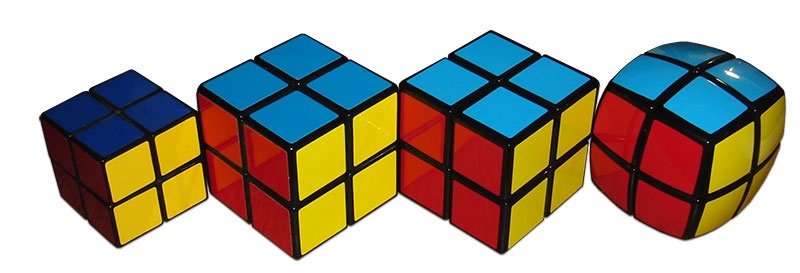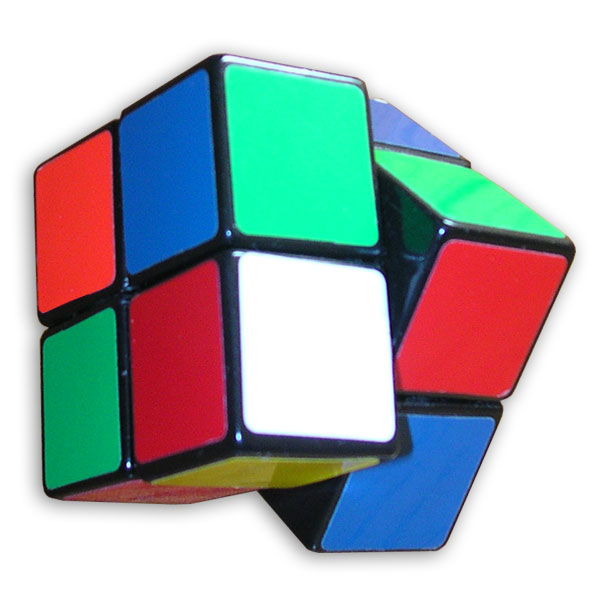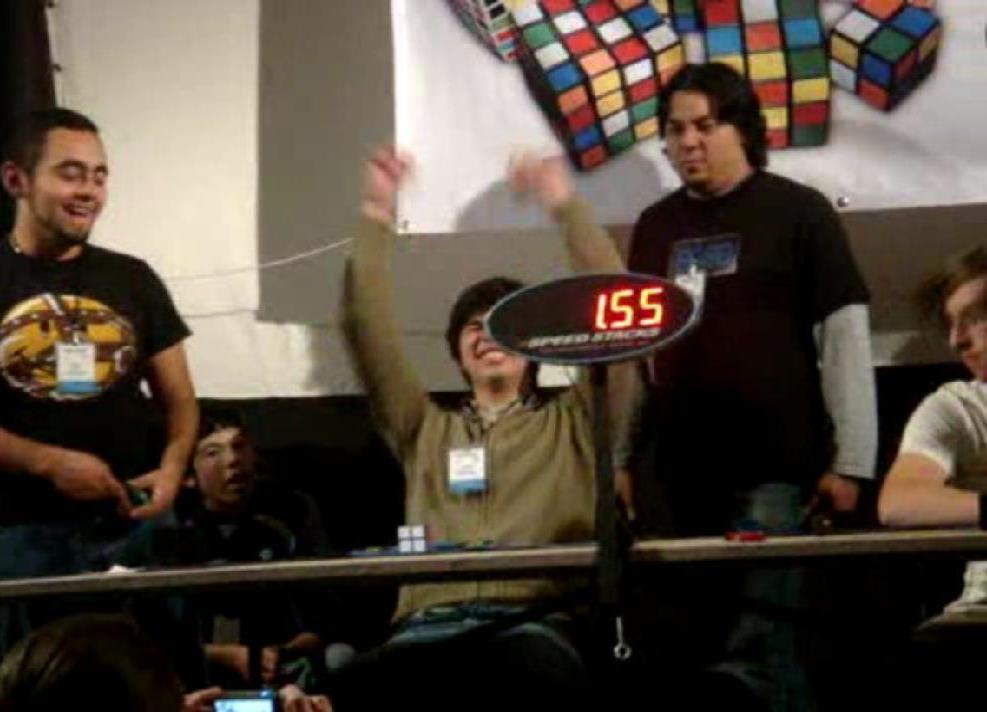2x2 Rubik's Cube on:
[Wikipedia]
[Google]
[Amazon]
 The 2x2 Rubik's Cube (also known as the Pocket Cube or Mini Cube) is a 2×2×2 version of the
The 2x2 Rubik's Cube (also known as the Pocket Cube or Mini Cube) is a 2×2×2 version of the
 In March 1970,
In March 1970,
 Any
Any
/ref> The number ''a'' of positions that require ''n'' ''any'' (half or quarter) turns and number ''q'' of positions that require ''n'' quarter turns only are: The two-generator subgroup (the number of positions generated just by rotations of two adjacent faces) is of order 29,160. Code that generates these results can be found here.
 The world record fastest solve is 0.47 seconds, set by Guanbo Wang (王冠博) of
The world record fastest solve is 0.47 seconds, set by Guanbo Wang (王冠博) of
The world record average of 5 solves (excluding fastest and slowest) is 1.02 seconds, set by Zayn Khanani of The United States on 12 February 2022 at Cape Fear 2022, with the times 1.11, (0.71), 1.04, 0.90 and (1.21) seconds.
Methods for speedsolving the 2x2x2code for enumerating all permutations of a rubik's cube
{{Rubik's Cube Rubik's Cube
 The 2x2 Rubik's Cube (also known as the Pocket Cube or Mini Cube) is a 2×2×2 version of the
The 2x2 Rubik's Cube (also known as the Pocket Cube or Mini Cube) is a 2×2×2 version of the Rubik's Cube
The Rubik's Cube is a Three-dimensional space, 3-D combination puzzle originally invented in 1974 by Hungarians, Hungarian sculptor and professor of architecture Ernő Rubik. Originally called the Magic Cube, the puzzle was licensed by Rubik t ...
. The cube
In geometry, a cube is a three-dimensional solid object bounded by six square faces, facets or sides, with three meeting at each vertex. Viewed from a corner it is a hexagon and its net is usually depicted as a cross.
The cube is the only r ...
consists of 8 pieces, all corners.
History
 In March 1970,
In March 1970, Larry D. Nichols
Larry D. Nichols, born 1939 in the United States, is a puzzle designer. He grew up in Xenia, Ohio, and studied chemistry at DePauw University in Greencastle, Indiana, before moving to Massachusetts to attend Harvard Graduate School. He is be ...
invented a 2×2×2 "Puzzle with Pieces Rotatable in Groups" and filed a Canadian patent application for it. Nichols's cube was held together with magnets. Nichols was granted on April 11, 1972, two years before Rubik invented his Cube.
Nichols assigned his patent to his employer Moleculon Research Corp., which sued Ideal
Ideal may refer to:
Philosophy
* Ideal (ethics), values that one actively pursues as goals
* Platonic ideal, a philosophical idea of trueness of form, associated with Plato
Mathematics
* Ideal (ring theory), special subsets of a ring considere ...
in 1982. In 1984, Ideal lost the patent infringement suit and appealed. In 1986, the appeals court affirmed the judgment that Rubik's 2×2×2 Pocket Cube infringed Nichols's patent, but overturned the judgment on Rubik's 3×3×3 Cube.
Permutations
 Any
Any permutation
In mathematics, a permutation of a set is, loosely speaking, an arrangement of its members into a sequence or linear order, or if the set is already ordered, a rearrangement of its elements. The word "permutation" also refers to the act or proc ...
of the eight corners is possible (8 ! positions), and seven of them can be independently rotated (37 positions). There is nothing identifying the orientation
Orientation may refer to:
Positioning in physical space
* Map orientation, the relationship between directions on a map and compass directions
* Orientation (housing), the position of a building with respect to the sun, a concept in building de ...
of the cube in space, reducing the positions by a factor of 24. This is because all 24 possible positions and orientations of the first corner are equivalent due to the lack of fixed centers (similar to what happens in circular permutations). This factor does not appear when calculating the permutations of ''N''×''N''×''N'' cubes where ''N'' is odd, since those puzzles have fixed centers which identify the cube's spatial orientation. The number of possible positions of the cube is
:
The maximum number of turns required to solve the cube is up to 11 half or quarter turns, or up to 14 quarter turns only.Jaapsch.net: Pocket Cube/ref> The number ''a'' of positions that require ''n'' ''any'' (half or quarter) turns and number ''q'' of positions that require ''n'' quarter turns only are: The two-generator subgroup (the number of positions generated just by rotations of two adjacent faces) is of order 29,160. Code that generates these results can be found here.
Methods
A pocket cube can be solved with the same methods as a 3x3x3Rubik's cube
The Rubik's Cube is a Three-dimensional space, 3-D combination puzzle originally invented in 1974 by Hungarians, Hungarian sculptor and professor of architecture Ernő Rubik. Originally called the Magic Cube, the puzzle was licensed by Rubik t ...
, simply by treating it as a 3x3x3 with solved (invisible) centers and edges. More advanced methods combine multiple steps and require more algorithms. These algorithms designed for solving a 2x2x2 cube are often significantly shorter and faster than the algorithms one would use for solving a 3x3x3 cube.
The Ortega method, also called the Varasano method, is an intermediate method. First a face is built (but the pieces may be permuted incorrectly), then the last layer is oriented (OLL) and lastly both layers are permuted (PBL). The Ortega method requires a total of 12 algorithms.
The CLL method first builds a layer (with correct permutation) and then solves the second layer in one step by using one of 42 algorithms. A more advanced version of CLL is the TCLL Method also known as Twisty CLL. One layer is built with correct permutation similarly to normal CLL, however one corner piece can be incorrectly oriented. The rest of the cube is solved, and the incorrect corner orientated in one step. There are 83 cases for TCLL. Algorithms have been generated for solving all of them.
The most advanced method is the EG method. It also starts by building a layer (in any permutation), but then solves the rest of the puzzle in one step. It requires knowing 128 algorithms, 42 of which are the CLL algorithms.
Top-level speedcubers may also 1-look the puzzle,
which involves inspecting the entire cube and planning as much of the solution as possible before starting the solve by predicting where the pieces will go after finishing a side.
Notation
2x2x2 notation is based on 3x3x3 notation but some moves are redundant (All moves are 90°, moves ending with ‘2’ are 180° turns): *R represents a clockwise turn of the right face of the cube *U represents a clockwise turn of the top face of the cube *F represents a clockwise turn of the front face of the cube *R' represents an anti-clockwise turn of the right face of the cube *U' represents an anti-clockwise turn of the top face of the cube *F' represents an anti-clockwise turn of the front face of the cubeWorld records
 The world record fastest solve is 0.47 seconds, set by Guanbo Wang (王冠博) of
The world record fastest solve is 0.47 seconds, set by Guanbo Wang (王冠博) of China
China, officially the People's Republic of China (PRC), is a country in East Asia. It is the world's most populous country, with a population exceeding 1.4 billion, slightly ahead of India. China spans the equivalent of five time zones and ...
on 26 November 2022 at Northside Spring Saturday 2022 in Brisbane, Australia
Australia, officially the Commonwealth of Australia, is a Sovereign state, sovereign country comprising the mainland of the Australia (continent), Australian continent, the island of Tasmania, and numerous List of islands of Australia, sma ...
. World Cube Associationbr>Official Results - 2x2x2 CubeThe world record average of 5 solves (excluding fastest and slowest) is 1.02 seconds, set by Zayn Khanani of The United States on 12 February 2022 at Cape Fear 2022, with the times 1.11, (0.71), 1.04, 0.90 and (1.21) seconds.
Top 5 solvers by single solve
Top 5 solvers by average of 5 solves World Cube Associationbr>Official 2x2x2 Ranking Average
/ref>
See also
*Rubik's Cube
The Rubik's Cube is a Three-dimensional space, 3-D combination puzzle originally invented in 1974 by Hungarians, Hungarian sculptor and professor of architecture Ernő Rubik. Originally called the Magic Cube, the puzzle was licensed by Rubik t ...
(3×3×3)
* Rubik's Revenge (4×4×4)
* Professor's Cube (5×5×5)
* V-Cube 6 (6×6×6)
* V-Cube 7 (7×7×7)
* V-Cube 8 (8×8×8)
* Combination puzzle
References
External links
Methods for speedsolving the 2x2x2
{{Rubik's Cube Rubik's Cube